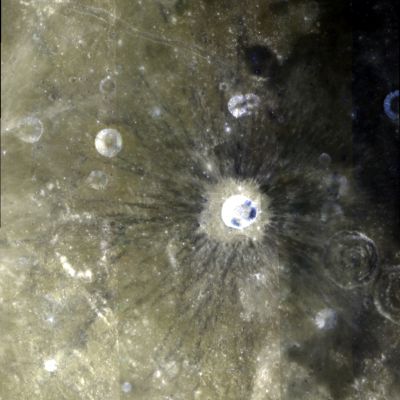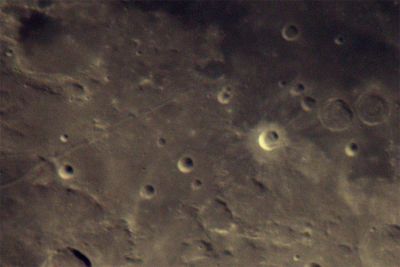Dionysius
Contents
Dionysius (and its system of dark rays)
|
Lat: 2.8°N, Long: 17.3°E, Diam: 18 km, Depth: 1.2 km, Rükl: 35, Copernican |


Left: Clementine color, Right: Henrik Bondo
The Clementine photograph at left shows very well the odd system of dark rays which surrounds Dionysius.
Images
LPOD Photo Gallery Lunar Orbiter Images Apollo Images
Two extraordinary close-ups of Dionysius, made by Lunar Orbiter 5, are seen here (frames 080 and 083). One of them, Frame 083, shows also the little craterlet between Ritter B and C, which is an interesting target for those who want to test their telescope's optics (source: the dedicated moon-observer Antoine van der Jeugt). Research Lunar Orbiter 5 photographs: Danny Caes.
Maps
(LAC zone 60D3) LAC map Geologic map LM map AIC map
Description
Dionysius is quite an easy target during Full Moon, and an exquisite example of a High-Albedo crater whose unique system of dark rays were overlooked for hundreds of years, until reported in 1965 by Vern Smalley.
The LPOD Leonardo and Miguel shows an interesting photograph of the Waxing Crescent Moon, with earthshine, and also the remarkably distinct looking bright crater Dionysius in it (beyond the western "coast" of Mare Tranquillitatis). The cause of its distinct appearance (of Dionysius) is perhaps the system of dark rays around it, which makes Dionysius some kind of "popping out" crater, especially during "full moon" circumstances. - DannyCaes Feb 8, 2014
Description: Elger
(IAU Directions) DIONYSIUS.--This crater, 13 miles in diameter, is one of the brightest spots on the lunar surface. It stands on the W. border of the Mare, about 30 miles W.N.W. of Ritter. A distinct crater-row runs round its outer border on the E., and ultimately, as a delicate cleft, strikes across the Mare to the W. side of Ritter. Both crater-row and cleft are easy objects in a 4 inch achromatic under morning illumination.
Description: Wikipedia
Additional Information
- Depth data from Kurt Fisher database
- Westfall, 2000: 1.2 km
- Viscardy, 1985: 2.7 km
- Cherrington, 1969: 2.52 km
- Inner wall scarp a steep 46° (Pohn, 1963).
- Included in ALPO list of bright ray craters
- High-Albedo crater Dionysius is a good target to observe possible reflected light on its shadowed inner slopes (a couple of days after local sunrise, or a couple of days before local sunset).- DannyCaes Apr 27, 2009 See also: High-Albedo inner slopes and reflected light
- TSI = 20, CPI = 5, FI = 20; MI =45 Smith and Sanchez, 1973
- Dionysius is surrounded by a peculiar system of dark rays.
Nomenclature
- Named for St. Dionysius (or: Dionysius the Areopagite), a little known saint who Rükl reports observed a solar eclipse when Christ was crucified. Along with the saintly trio Theophilus, Cyrillus and Catharina, one of the few craters named for a religious person (other than the Jesuit astronomers of the 1600-1700s).
- According to Whitaker (p. 212), this name was introduced (in the form S. Dionysius) by Riccioli (on Riccioli's map as S.Dionys.Areop.), although he used it for the crater now called Delambre. Whitaker doesn't explain who moved the name to its present location. - JimMosher
- Dionysius Dark Rays, an interesting unofficial name printed on page 37 (chart 12) in the 21st Century Atlas of the Moon (2012).
LPOD Articles
How Deep is that Hole? Regional view
Lunar 100
L93: Unusual & rare dark rays.
Bibliography
Remote Sensing Studies of the Dionysius Region of the Moon. Giguere and others (2005) LPSC 36, #1092. Full article